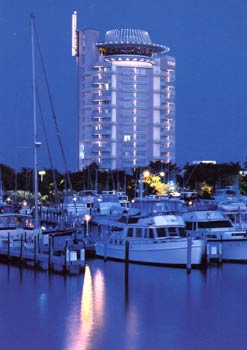Boaters Urged To Understand Hazard
Each year, boaters are injured or killed by carbon monoxide. Most occur on older boats and within the cabin or other enclosed areas. In recent years, federal investigations have focused on a series of accidents involving large houseboats in which the exhaust from gasoline generators has injured or killed individuals.
While this article is aimed at large houseboats, this problem also exists in yachts and even ski boats. It has recently become illegal in some states to allow hang on the swim step and be pulled.
You probably know
that carbon monoxide poisoning is a danger when gasoline-powered
engines are run in enclosed spaces. What many people don’t
know is that severe carbon monoxide poisoning can also occur outdoors
and has been linked with houseboats.
The Problem
Since 1994, there have
been at least nine carbon monoxide-related deaths on houseboats,
and more than 100 non-fatal poisonings in the U.S. Studies indicate
that houseboats with on-board electricity generators that vent
toward the rear of the boat can pose a danger of carbon monoxide
poisoning to people on the rear swim deck or water platform. Carbon
monoxide poisonings have also occurred inside houseboats.
Gasoline-powered engines
on houseboats, including the houseboat’s onboard generator,
produce carbon monoxide, a colorless and odorless gas that can
poison or kill someone who breathes in too much of it. Carbon
monoxide tends to build up above the water near the water platform.
The amount of carbon monoxide that can build up in the air space
beneath the stern deck on houseboats can be deadly within seconds
to minutes and can also reach life-threatening concentrations
on and near the swim deck.
The Effects
The most common symptoms
of carbon monoxide poisoning are headache, dizziness, weakness,
nausea, vomiting, chest pain, and confusion. High levels of carbon
monoxide can cause loss of consciousness and death, or can cause
someone to pass out and fall into the water and drown. Unless
suspected, carbon monoxide poisoning can be difficult to diagnose
because the symptoms seem like other illnesses. People who are
sleeping or intoxicated can die from carbon monoxide poisoning
before ever experiencing symptoms.
If you think someone
on your houseboat has carbon monoxide poisoning, move him or her
to fresh air quickly and contact your nearest emergency services.
Prevention
How can you prevent carbon monoxide poisoning on or around your houseboat?
Install and maintain a working carbon monoxide detector inside the houseboat
(remember, this won’t alert people to dangerous levels of
carbon monoxide at locations outside the houseboat cabin, such
as the swim deck).
Make sure that all fuel-burning engines and appliances are properly
installed, maintained, and operated.
Educate all passengers about the signs, symptoms, and treatment
of carbon monoxide poisoning, especially if the houseboat has
a rear swim deck or water platform.
Watch children closely when they are playing on rear swim decks
or water platforms for signs of carbon monoxide poisoning.
Swim and enjoy other activities away from areas where gasoline-powered
engines vent their exhaust.
Title:Boating
Safety
Last Updated: February 22, 2005
|
|
